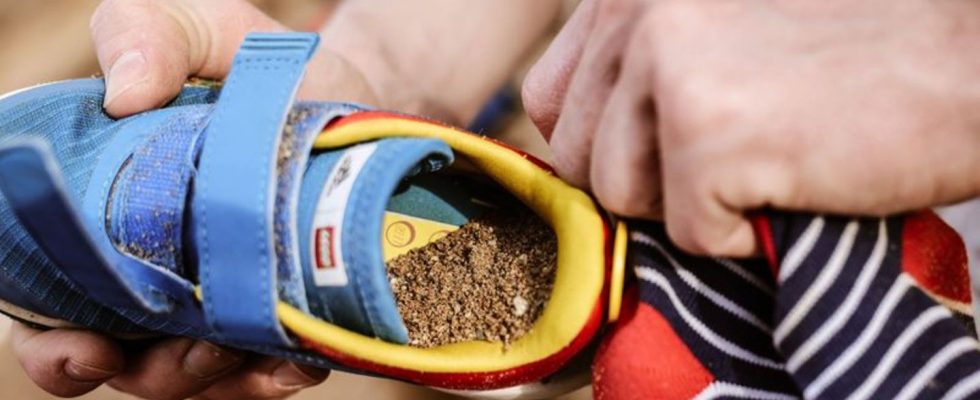Spring is coming – and anyone who has children will notice that soon there will be mountains of sand piling up in the hallway again. Why is that? A journey to one of humanity’s last mysteries.
The big redistribution will soon begin again. It begins in playgrounds and in daycare center sandboxes – and ends in the hallway at home. When children come home from playing outside – as is increasingly the case in spring – they have brought something with them.
And although you should actually be prepared for it, you are always surprised at how much there is: sand. Heap after heap trickles onto the floor as soon as the shoes are taken off. “Didn’t you notice?” you ask with a mixture of parental amazement and stupidity. And looks into expressionless faces.
Where does the sand come from?
Sand and shoes is not a new combination in terms of cultural history. “I still have sand in my shoes from Hawaii,” the pop bard Bata Illic once said happily in one of his songs – that was back in 1975. But especially when it comes to children, it’s worth taking a closer look. Because sand trickling out of tiny shoes is one of the recurring and therefore structuring experiences in the lives of people who have to do with young people on earth. A unifying element – and how many of them are there left?
It is relatively clear where the sand comes from: from sandboxes and playgrounds, the natural habitats of one to five year olds. What is quite astonishing, however, is the amount that children can carry in their shoes for hours, apparently without being moved. You don’t suspect anything, you don’t hear any complaints, and in the end the floor looks like the desert planet in the movie “Dune”. How can that be?
Why don’t children notice the sand?
A call to Arne-Björn Jäger, senior physician in orthopedics, he should know. But he also initially emphasizes: “This is a complex question!” The foot is a “delicate structure,” says Jäger. “It consists of many individual bones – 28 in total, which are jointly connected. There are also ligaments and muscles.”
When it comes to feeling sand, that’s where things get really complicated. On the one hand, there is the so-called protopathic system, says the doctor from Trier. This is the protective system – it conveys pain, rough touch and also temperature. “If we step on something very hot, we pull our foot away.”
This system develops very early, in the womb. There is also the so-called epicritic system. It is able to recognize shapes or notice tightness. “It is also this system that tells us that there is sand in the shoe. Sand per se is not something that causes severe pain,” says Jäger. “The difference now is: The epicritic system only develops gradually. It is subject to a learning process. And in many children it is apparently not yet sufficiently developed to notice the sand in their shoes.”
Is the sand harmful?
When you have a good orthopedic surgeon on the phone, you naturally ask him whether you as a parent should be worried. But Jäger waves it off. “I’ve never seen a child suffer anatomical damage from sand in their shoe. At most, a blister,” he says. Phew.
The analysis corresponds to the impressions gained from the Federal Association of the Shoe and Leather Goods Industry. There, spokeswoman Claudia Schulz also refers to the phenomenon that small children apparently do not yet have a strong sense of pressure. “That’s why trying on shoes is always such a thing,” she says. Children often said that a shoe fit even though it was actually too small – because they liked it. “Because they don’t feel the pressure.” You have to imagine children as happy people.
How do you get rid of the sand?
This seems to explain why the alarm was not raised well before the large-scale watering of the hallway. We’ve known how to deal with this for a long time, that’s worth adding. “I would always rely on vacuuming if sand is dirty,” says Hélène Staiber, master building cleaner.
“Vacuuming is important, especially on rough floors, so that the sand comes out of the depressions.” Exception: high-gloss tiles, which may scratch. Then comes the time for brooms and dustpans.
So are the playgrounds missing sand?
Last construction site: the playgrounds. What do they actually do when they keep losing sand? “The need to refill or replace sand is determined through regular checks,” explains a spokesman for the city of Cologne, as usual coolly. “The sand at the playgrounds is replenished or replaced regularly and as needed.”
That probably means: supplies are provided. The redistribution can continue.

